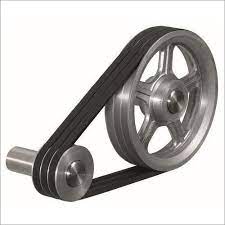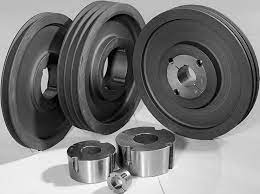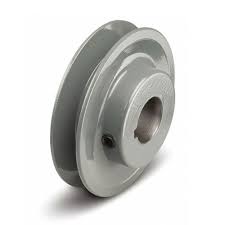Product Description
Product Description
The drum is the main component that transmits power. It is divided into 3 types according to their load-carrying capacity: light, medium and heavy.
Light: Bearing aperture 80-100mm, the shaft and hub are single-width plate welded cylinder structure connected by single key.
Medium: Bearing aperture 120-180mm, the shaft and hub are expansion sleeve connection
Heavy: Bearing aperture 200-220mm, the shaft and hub are expansion sleeve connection, and the drum body is cast-welded structure.
Conveyor pulley stays at 2 ends of belt machine. The pulley can be divided into 2 categories: Driving pulley and averting pulley, driving pulley is the main part for transmitting the power and there are 2 kinds of pulley sets: Smooth surface and rubber surface, and rubber surface can be classified into smooth rubber surface, herringbone rubber surface and CHINAMFG rubber surface to meet different technical requirements. Averting pulley can be classified into smooth rubber surface and smooth steel surface.
Detailed Photos
Technical Parameters
|
Driving Pulley (rubber surface) |
|
|
Belt Width |
Standard Diameter of Pulley |
|
500 mm |
500mm |
|
650 mm |
500mm,630 mm |
|
800 mm |
500mm,630mm,800mm,1000mm,1250mm,1400 mm |
|
1000 mm |
630mm,800mm,1000mm,1250mm,1400 mm |
|
1200 mm |
630mm,800mm,1000mm,1250mm,1400 mm |
|
1400 mm |
630mm,800mm,1000mm,1250mm,1400 mm |
|
1600 mm |
630mm,800mm,1000mm,1250mm,1400 mm |
|
1800 mm |
630mm,800mm,1000mm,1250mm,1400 mm |
|
2000 mm |
800mm,1000mm,1250mm,1400 mm |
|
2200 mm |
1000mm,1250mm,1400 mm |
|
2400 mm |
1000mm,1250mm,1400 mm |
|
Bend Pulley (smooth surface & rubber surface) |
|
|
Belt Width |
Standard Diameter of Pulley (mm) |
|
500 mm |
250,315,400,500 |
|
650 mm |
250,315,400,500,630 |
|
800 mm |
250,315,400,500,630,800,1000,1250 |
|
1000 mm |
250,315,400,500,630,800,1000,1250,1400 |
|
1200 mm |
250,315,400,500,630,800,1000,1250,1400 |
|
1400 mm |
315,400,500,630,800,1000,1250,1400 |
|
1600 mm |
400,500,630,800,1000,1250,1400 |
|
1800 mm |
400,500,630,800,1000,1250,1400 |
|
2000 mm |
500,630,800,1000,1250,1400 |
|
2200 mm |
630,800,1000,1250,1400 |
|
2400 mm |
800,1000,1250,1400 |
|
Pulley Standard |
|
|
Brand |
SPD |
|
Specification |
SPD-CP-0001 |
|
Certificate |
ISO/BV/SGS |
|
Standard |
CEMA/JIS/DIN/Australia |
|
Application |
Coal mining industry, cement, steel, harbour etc. |
|
Place of Origin |
HangZhou City , ZheJiang Province , China |
|
Material Feature |
Water, Wear, Dust resistance |
|
Supply capacity |
80pcs/month |
|
Management system |
ISO 9001:2008,ISO 14001:2004,GB/T 28001-2001 |
Project Performance
Main Equipment & Facilitys
Customer Visit & Exhibition
Packaging & Shipping
Company Profile
HangZhou Port Shipbuilding & Machinery Industry Co., Ltd (RPIC) are a comprehensive group enterprise which is engaged in the design, manufacture, installation and maintenance of port bulk-handling equipment. Our company has the Third-level Qualification of Machinery & Electrical Equipment Installation Enterprise and First-Level Qualification of Equipment Maintenance Enterprise. Our company has already passed ISO9002: 2000, ISO14001 and OHSMS18001 system certification.
The business of our company covers the design, manufacture, installation and maintenance of steel structure projects, belt conveyor system projects, port auxiliary equipment, port handling equipment and their accessories. The main products of our company include traveling stackers, running mechanisms of portal cranes, belt conveyors, idler rollers, pulleys, grabs etc.
The products and services of HangZhou Port Machine Engineering Co., Ltd. Spread all over domestic and overseas port industry, electric power industry, metallurgy industry, energy industry, cement industry, food industry, paper industry, etc.
With professional technical teams, exquisite processing equipment, modern management systems and convenient transportation, our company adheres to the business philosophy of “integrity and innovation, working hard to manufacture high quality products and constructe excellent projects, providing customers with value-added services”.
The quality control is carried out throughout the whole production process. We pursue perfection in the design and production of each product. With advanced processing equipment, we are committed to providing superior quality products and services.
RPIC is a leading professional bulk material conveying system equipment supplier. The capacity of conveying equipment can reach 10, 000t/h.
RPIC is a professional equipment installation and maintenance service provider which has the First-level Qualification of the Equipment Maintenance Enterprise.
Our products are well sold to Europe, Australia, America, Asia and African.
We welcome all companies to contact us for business negotiation.
Our EPC Conveying System Project
our certification
FAQ
Q1:Can you send samples? A:Of course, we can provide customers with free samples but customer should pay the courier fee.
Q2:What product information do I need to provide? A:Please kindly provide the grade, width, thickness, surface treatment requirement and quantities you need to purchase
Q3:What is your terms of payment ? A: 30% T/T in advance ,balance before shipment or 100% LC at sight.
Q4.Do you provide customer made Products service? A: Yes,if you have your own design , we can produce according to your specification and drawing.
Q5:How long does your delivery time take? A:In general, our delivery time is within 7-15 days, and may be longer if the quantity is extremely large or special circumstances occur.
Q6: How many countries you already exported to? A:We have exported to America, Canada, Brazil, Chile, Colombia, Thailand, Myanmar, Vietnam, and other African countries.Our export experience is rich, we familiar with different market demands, can help customers avoid a lot of trouble
Q7:Can I go to your factory to visit? A:Of course, we welcome customers from all over the world to visit our factory
Q8:Does the product have quality inspection before loading? A:Of course, all our products are strictly tested for quality before packaging, customers can appoint third parties to inspect the products before loading too
Q9:How to pack the products? A: Standard export sea-worthy packaging, the inner layer has a waterproof paper outer layer with iron packaging and is fixed with a fumigation wooden pallet. It can effectively protect products from corrosion and various climate changes during CHINAMFG transportation
Q10:What is your working time? A:In general, our online service time is ZheJiang time: 8:00-22:00, after 22:00, we will reply to your inquiry in the coming working day.
/* January 22, 2571 19:08:37 */!function(){function s(e,r){var a,o={};try{e&&e.split(“,”).forEach(function(e,t){e&&(a=e.match(/(.*?):(.*)$/))&&1
| Material: | Steel |
|---|---|
| Application: | Chemical Industry, Grain Transportation, Mining Transport, Power Plant |
| Structure: | Spring Plate Type Roller |
| Customization: |
Available
| Customized Request |
|---|
.shipping-cost-tm .tm-status-off{background: none;padding:0;color: #1470cc}
|
Shipping Cost:
Estimated freight per unit. |
about shipping cost and estimated delivery time. |
|---|
| Payment Method: |
|
|---|---|
|
Initial Payment Full Payment |
| Currency: | US$ |
|---|
| Return&refunds: | You can apply for a refund up to 30 days after receipt of the products. |
|---|

How do you select the right drive belt pulley for a specific vehicle or machinery?
Selecting the right drive belt pulley for a specific vehicle or machinery involves considering several factors to ensure optimal performance and compatibility. Here’s a detailed explanation of the selection process:
1. Determine the Belt Type:
Identify the type of belt required for the application. Common belt types include V-belts, timing belts, flat belts, and ribbed belts. Each belt type has specific design features and requirements that dictate the corresponding pulley design.
2. Determine Power Requirements:
Calculate or determine the power requirements of the system. Consider factors such as the torque and speed requirements, as well as the desired power transmission efficiency. This information will help determine the appropriate pulley size and design to handle the required power load.
3. Consider Speed Ratio:
If the application requires a specific speed ratio between the driving and driven components, such as in timing systems or variable speed applications, calculate the desired speed ratio. This will guide the selection of pulley sizes and the number of teeth or grooves required for proper speed synchronization.
4. Assess Space Constraints:
Evaluate the available space and clearance within the machinery or vehicle. Consider factors such as pulley diameter, width, and overall dimensions. Ensure that the selected pulley can be properly installed and aligned within the available space without interfering with other components.
5. Check Shaft Requirements:
Verify the dimensions and specifications of the shafts on both the driving and driven components. Consider factors such as shaft diameter, keyway size, and shaft mounting options. Ensure that the selected pulley has the appropriate bore size and shaft attachment mechanism to fit the shafts securely.
6. Assess Pulley Material and Construction:
Consider the operating conditions and environment in which the pulley will be used. Evaluate factors such as temperature, humidity, chemical exposure, and abrasive conditions. Choose a pulley material and construction that can withstand these conditions, such as steel, cast iron, aluminum, or plastic.
7. Consult Manufacturer Specifications:
Refer to the manufacturer’s specifications and guidelines for the specific vehicle or machinery. Manufacturers often provide recommendations and guidelines for selecting the appropriate pulleys based on their products’ design and requirements. These specifications may include pulley dimensions, belt compatibility, and power handling capabilities.
8. Seek Expert Advice if Required:
If you are unsure about the selection process or have specific requirements, it is advisable to consult with experts or manufacturers who specialize in power transmission systems. They can provide guidance and recommendations based on their expertise and experience.
By considering these factors and following the selection process, you can choose the right drive belt pulley for a specific vehicle or machinery. This ensures compatibility, optimal power transmission, and reliable operation, contributing to the overall efficiency and performance of the system.

How do drive belt pulleys impact the performance of industrial machinery?
Drive belt pulleys play a significant role in the performance of industrial machinery. Here’s a detailed explanation of how drive belt pulleys impact the performance of industrial machinery:
1. Power Transmission:
Drive belt pulleys are responsible for transmitting power from the motor or engine to various components of industrial machinery. They provide the mechanical linkage between the power source and driven equipment, such as pumps, compressors, conveyors, and machines. The design and quality of the pulleys directly affect the efficiency and reliability of power transmission, impacting the overall performance of the machinery.
2. Speed Control:
Drive belt pulleys are instrumental in controlling the rotational speed of driven equipment. By using pulleys of different sizes or employing pulley systems with multiple belts, the speed ratio can be adjusted to meet specific operational requirements. This allows for precise control of machinery speed, which is crucial in applications that require varying operating speeds or synchronization with other processes.
3. Torque Transfer:
Drive belt pulleys facilitate the transfer of torque from the motor or engine to the driven equipment. The pulley design, including its diameter, groove size, and belt type, determines the torque-carrying capacity. Properly sized and designed pulleys ensure that the required torque is effectively transferred to the driven components, enabling the machinery to perform the necessary tasks with adequate force.
4. Belt Tension and Stability:
Drive belt pulleys help maintain proper belt tension, which is crucial for the stability and performance of industrial machinery. Tensioned belts ensure reliable power transmission by preventing slippage and maintaining sufficient contact between the pulleys and belts. The pulley design may include features such as tensioning mechanisms or adjustable pulley positions to facilitate proper belt tensioning and stability.
5. Load Distribution:
Drive belt pulleys aid in distributing the load across the machinery’s components. By properly sizing and aligning the pulleys, the load can be evenly distributed among the belts, pulleys, and driven equipment. This helps prevent excessive wear and stress on individual components, prolonging their lifespan and ensuring the overall performance and durability of the machinery.
6. Noise and Vibration Reduction:
Well-designed drive belt pulleys contribute to reducing noise and vibration levels in industrial machinery. Proper alignment, balance, and surface quality of the pulleys minimize vibration and noise generation during operation. This enhances the working environment, reduces operator fatigue, and improves overall equipment performance.
7. Maintenance and Serviceability:
The design of drive belt pulleys can impact the ease of maintenance and serviceability of industrial machinery. Pulleys that are accessible, have removable covers or guards, and allow for straightforward belt replacement or tension adjustment simplify maintenance procedures. This reduces downtime and ensures that the machinery remains operational and productive.
8. System Flexibility and Adaptability:
Drive belt pulleys offer flexibility and adaptability in industrial machinery. They allow for the integration of different power sources and driven equipment, enabling customization and expansion of the machinery’s capabilities. By changing pulley sizes or configurations, the machinery can be adapted to different operating conditions, power requirements, or production demands.
Overall, drive belt pulleys have a crucial impact on the performance of industrial machinery. They facilitate power transmission, speed control, torque transfer, belt tension, load distribution, noise reduction, maintenance, and system flexibility. Proper selection, design, and maintenance of drive belt pulleys are essential to optimize the performance, efficiency, and reliability of industrial machinery.

What are the advantages of using drive belt pulleys in automotive engines?
Drive belt pulleys offer several advantages when used in automotive engines. Here’s a detailed explanation of the advantages of using drive belt pulleys in automotive engines:
1. Power Distribution:
Drive belt pulleys enable efficient power distribution within the automotive engine. They transfer power from the engine’s crankshaft to various components such as the alternator, water pump, power steering pump, air conditioning compressor, and supercharger. This ensures that these components receive the necessary power to operate effectively, contributing to the overall performance of the vehicle.
2. Versatility:
Drive belt pulleys are versatile components that can accommodate multiple belts and drive various accessories simultaneously. They can be designed to have multiple grooves, allowing them to drive different systems and components within the automotive engine. This versatility enables the integration of various systems and accessories, enhancing the functionality and convenience of the vehicle.
3. Easy Maintenance:
Drive belt pulleys are relatively easy to maintain and replace. If a belt becomes worn or damaged, it can be easily removed and replaced without the need for extensive disassembly of the engine. This simplifies maintenance tasks and reduces downtime during repairs or belt replacements, ensuring that the vehicle can be quickly back on the road.
4. Efficiency and Performance:
Drive belt pulleys contribute to the overall efficiency and performance of automotive engines. By properly transferring power to driven components, they ensure the optimal operation of systems such as the alternator for electrical generation, the water pump for engine cooling, and the power steering pump for smooth steering. This results in improved fuel efficiency, reliable performance, and enhanced driving experience.
5. Cost-Effectiveness:
Using drive belt pulleys in automotive engines can be cost-effective. Compared to alternative power transmission systems, such as gear-driven systems, drive belt pulleys are often more affordable to manufacture and maintain. They also provide flexibility in accommodating different belt sizes and types, allowing for cost-effective customization based on specific vehicle requirements.
6. Noise and Vibration Damping:
Drive belt pulleys help dampen noise and vibrations generated by the engine and other components. The flexibility and elasticity of the belt, along with the design of the pulley, act as a cushion, reducing the transmission of vibrations and providing smoother operation. This contributes to a quieter and more comfortable driving experience.
7. Compact Design:
Drive belt pulleys have a compact design, which is advantageous in automotive engines where space is often limited. They can be integrated into the engine layout without requiring significant additional space or complex modifications. This compact design allows for efficient packaging of the engine components and contributes to overall vehicle weight reduction.
8. Customization and Compatibility:
Drive belt pulleys can be customized and designed to be compatible with specific automotive engine configurations. This ensures proper fitment and alignment with the engine’s components, reducing the risk of misalignment, slippage, or premature wear. Customization also allows for the adaptation of drive belt pulleys to different vehicle models and engine variations.
Overall, the use of drive belt pulleys in automotive engines provides advantages such as efficient power distribution, versatility, easy maintenance, improved efficiency and performance, cost-effectiveness, noise and vibration damping, compact design, and customization options. These advantages contribute to the reliable operation, optimal performance, and enhanced driving experience of vehicles equipped with drive belt pulley systems.


editor by CX
2024-04-13